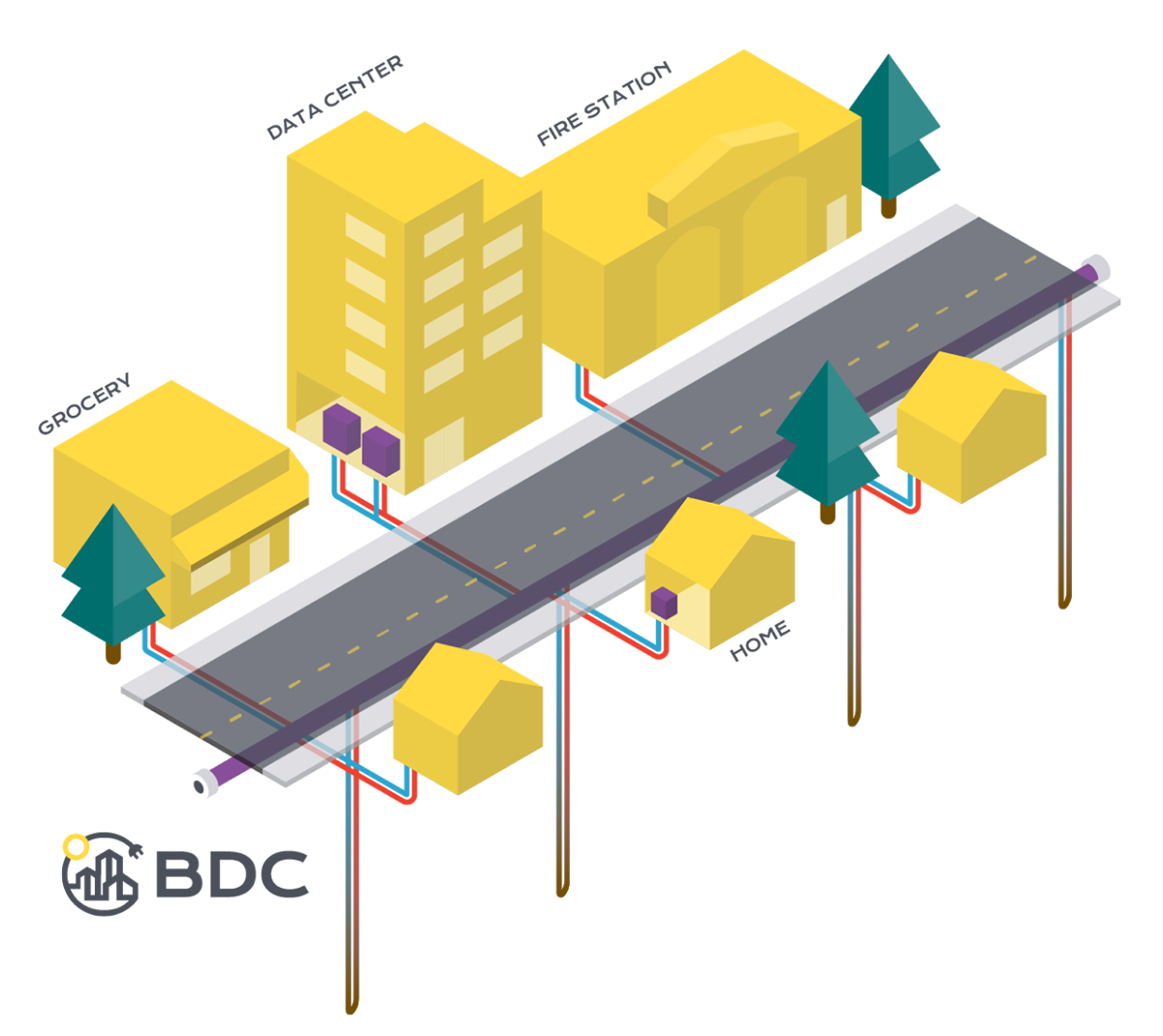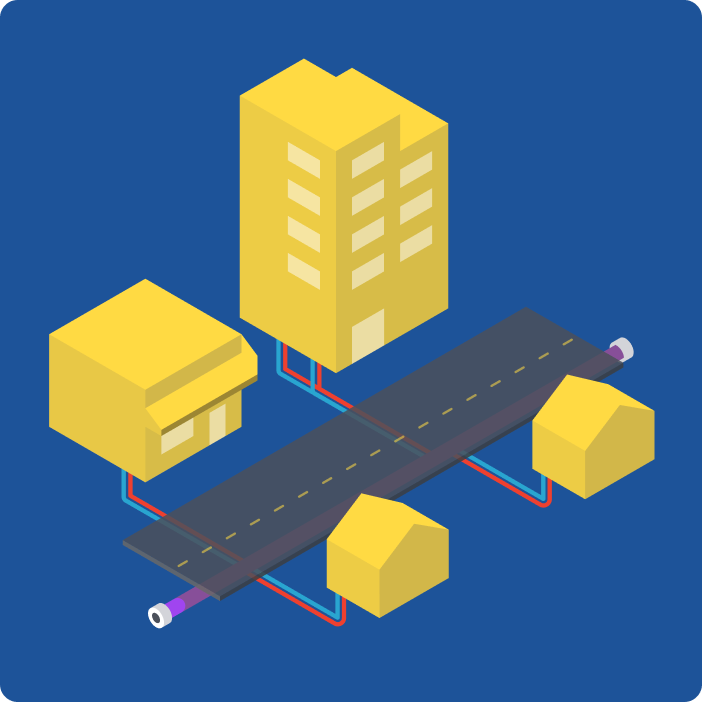
What Are Thermal Energy Networks?
TENs can deliver efficient, climate-friendly heating and cooling equitably to entire neighborhoods.
Thermal energy networks (TENs) use a shared network of water-filled pipes that transfer heat in and out of buildings. These neighborhood-scale systems allow buildings to exchange heat with a number of energy sources, such as lakes and rivers, energy-intensive buildings, wastewater systems, or the stable temperature of the earth.
Geothermal networks are TENs that uses shallow boreholes to harness the relatively constant thermal energy within the earth, then transfer that to all buildings on the network. These boreholes can capture and store excess heat underground for use days or months later, using the earth as a “thermal battery” and flattening peak electricity demand.
By installing TENs in the places where they bring the most benefit, we can reduce grid strain, safely replace leak-prone gas pipelines, and equitably deliver clean, modern technology to more neighborhoods.
Are TENs right for your neighborhood? Check out our Frequently Asked Questions to learn more.
TENs can deliver efficient, climate-friendly heating and cooling equitably to entire neighborhoods.
Thermal energy networks (TENs) use a shared network of water-filled pipes that transfer heat in and out of buildings. These neighborhood-scale systems allow buildings to exchange heat with a number of energy sources, such as lakes and rivers, energy-intensive buildings, wastewater systems, or the stable temperature of the earth.
Geothermal networks are TENs that uses shallow boreholes to harness the relatively constant thermal energy within the earth, then transfer that to all buildings on the network. These boreholes can capture and store excess heat underground for use days or months later, using the earth as a “thermal battery” and flattening peak electricity demand.
By installing TENs in the places where they bring the most benefit, we can reduce grid strain, safely replace leak-prone gas pipelines, and equitably deliver clean, modern technology to more neighborhoods.
Are TENs right for your neighborhood? Check out our Frequently Asked Questions to learn more.
Why TENs?
For Homes and Businesses
Comfortable
TENs use ground-source heat pumps that don’t just heat, they also cool — and they do it efficiently.
Efficient
TENs can achieve more than 500% efficiency, meaning households and businesses can lower their energy use.
Electric
TENs use heat pumps that run on electricity. There is no onsite combustion in this system — meaning no indoor exposure to pollutants like carbon monoxide and benzene.
Affordable
TENs are projected to lower energy bills due to their high efficiency. In addition, TENs remove a household’s fuel cost and avoid the volatility of fuel price spikes.
Local
TENs create energy independence by using a community’s own thermal resources, whether that is heat produced by local buildings or stored within soil or bedrock.

For Communities
Lower Emissions
TENs eliminate the use of fossil fuels for heating, dramatically reducing neighborhood emissions. As electricity grids across the U.S. adopt more renewable energy resources, overall emissions for these systems will decrease further.
Local Jobs
TENs provide a pathway for utility workers to transition to clean energy, bringing the skills they already have to communities that need them. Find out why unions in New York are excited about the potential of TENs in this video by the UpgradeNY collaboration.
Grid Savings
TENs are so efficient that they can eliminate the need for thousands of miles of electric transmission and distribution infrastructure — leading to electricity cost savings.
A Battery Beneath Your Feet
Shallow geothermal boreholes can store thermal energy in the bedrock for weeks or months, increasing the overall efficiency of a TEN.
Equitable Access
TENs are neighborhood-scale systems. All buildings on a street segment or neighborhood gain access to clean, renewable heating and cooling at the same time, and renters and low- and moderate-income customers do not have to pay for the upfront costs of the system.
Safe, Clean, Quiet
Once installed, you won’t hear or see a thermal energy network: its infrastructure is underground and noiseless. Systems with boreholes only reach shallow depths, and there is no risk of gas spills or leaks.
Reliable
Natural gas must travel hundreds or thousands of miles from wellhead to customer, making it vulnerable to leaks or spills en route. By contrast, TENs rely on local sources of energy and systems and can be designed with backup power.
Water Savings
TENs can save significant amounts of water by replacing evaporative cooling systems. For example, the Colorado Mesa University TEN cut its water use by 60% per square foot of conditioned space.

For Homes and Businesses
Comfortable
TENs use ground-source heat pumps that don’t just heat, they also cool — and they do it efficiently.
Efficient
TENs can achieve more than 500% efficiency, meaning households and businesses can lower their energy use.
Electric
TENs use heat pumps that run on electricity. There is no onsite combustion in this system — meaning no indoor exposure to pollutants like carbon monoxide and benzene.
Affordable
TENs are projected to lower energy bills due to their high efficiency. In addition, TENs remove a household’s fuel cost and avoid the volatility of fuel price spikes.
Local
TENs create energy independence by using a community’s own thermal resources, whether that is heat produced by local buildings or stored within soil or bedrock.

For Communities
Lower Emissions
TENs eliminate the use of fossil fuels for heating, dramatically reducing neighborhood emissions. As electricity grids across the U.S. adopt more renewable energy resources, overall emissions for these systems will decrease further.
Local Jobs
TENs provide a pathway for utility workers to transition to clean energy, bringing the skills they already have to communities that need them. Find out why unions in New York are excited about the potential of TENs in this video by the UpgradeNY collaboration.
Grid Savings
TENs are so efficient that they can eliminate the need for thousands of miles of electric transmission and distribution infrastructure — leading to electricity cost savings.
A Battery Beneath Your Feet
Shallow geothermal boreholes can store thermal energy in the bedrock for weeks or months, increasing the overall efficiency of a TEN.
Equitable Access
TENs are neighborhood-scale systems. All buildings on a street segment or neighborhood gain access to clean, renewable heating and cooling at the same time, and renters and low- and moderate-income customers do not have to pay for the upfront costs of the system.
Safe, Clean, Quiet
Once installed, you won’t hear or see a thermal energy network: its infrastructure is underground and noiseless. Systems with boreholes only reach shallow depths, and there is no risk of gas spills or leaks.
Reliable
Natural gas must travel hundreds or thousands of miles from wellhead to customer, making it vulnerable to leaks or spills en route. By contrast, TENs rely on local sources of energy and systems and can be designed with backup power.
Water Savings
TENs can save significant amounts of water by replacing evaporative cooling systems. For example, the Colorado Mesa University TEN cut its water use by 60% per square foot of conditioned space.

TENs Legislation
Currently, thirteen states have passed some form of TENs-enabling legislation. Click below to explore each state’s legislation in greater detail.
Currently, thirteen states have passed some form of TENs-enabling legislation. Click below to explore each state’s legislation in greater detail.
What is thermal energy?
Recent TENs Publications
Here, find key research on thermal energy networks from the Building Decarbonization Coalition.
Can Data Centers Heat Our Buildings?
The Future of Heat: Thermal Energy Networks as an Evolutionary Path for Gas Utilities Toward a Safe, Equitable, Just Energy Transition
Water-Smart Buildings: The Potential of Thermal Energy Networks to Cool Buildings & Conserve Water
Resources
-
Neighborhood-scale Solutions
BDC: Neighborhood Scale: The Future of Building DecarbonizationHow Heat Pumps Work
Canary Media: A Beginner’s Guide to the Different Types of Heat Pumps
RMI: Clean Energy 101: Geothermal heat pumpsThermal Energy Networks and Networked Geothermal
Gas to Geo Wiki
CityLimits: Could Thermal Energy Be New York’s Best Shot at Reaching its Climate Goals?
Fast Company: In this Massachusetts neighborhood, nearly every home is switching to geothermal energy
Heatmap News: A New Kind of Clean Energy Utility Is Born in Massachusetts
MIT Technology Review – Underground thermal energy networks are becoming crucial to the US’s energy future
Sightline: Without gas, what business models could gas utilities pursue?
WBUR: The country’s first gas utility-run networked geothermal heating and cooling system breaks ground in Mass.
NPR Marketplace: There’s a battery beneath your feet and utilities want to use it. -
UpgradeNY: NY Climate Week 2023
HEET: From Gas to Geo
Dandelion Energy: How Geothermal Works
Eversource: Networked Geothermal
National Grid: Geothermal Energy Program
Department of Energy, Energy 101: Geothermal Heat Pump -
Volts
April 1, 2022: Audrey Schulman and Zeyneb Magavi on how to replace natural gas with renewable heat
January 1, 2025: Thermal Energy Networks are the next big thingDecarbonize: The Clean Energy Podcast
September 21, 2022: How Networked Geothermal Can Help Minnesota Get Off Fossil GasEight Minute Climate Fix
March 11, 2024: Thermal Energy Networks feat. Matt Rusteika – Building Decarbonization Coalition -
Vermont Community Thermal Networks: How to Develop a Thermal Energy Network, a practical guide to adding thermal energy networks to decarbonization plans for your community.
If you want networked geothermal on your street sign up HERE. HEET is developing a map with site interest to encourage the gas to geo transition.
